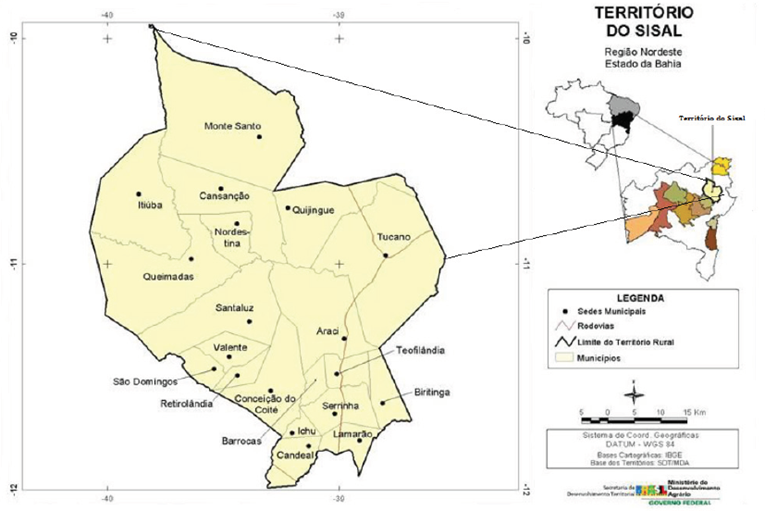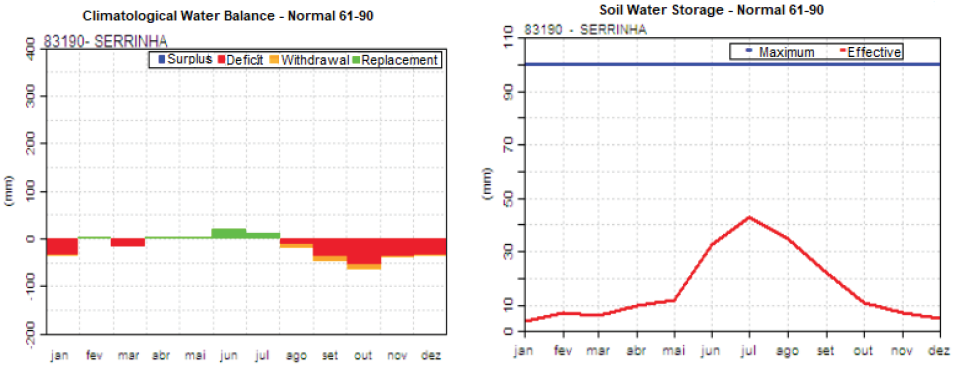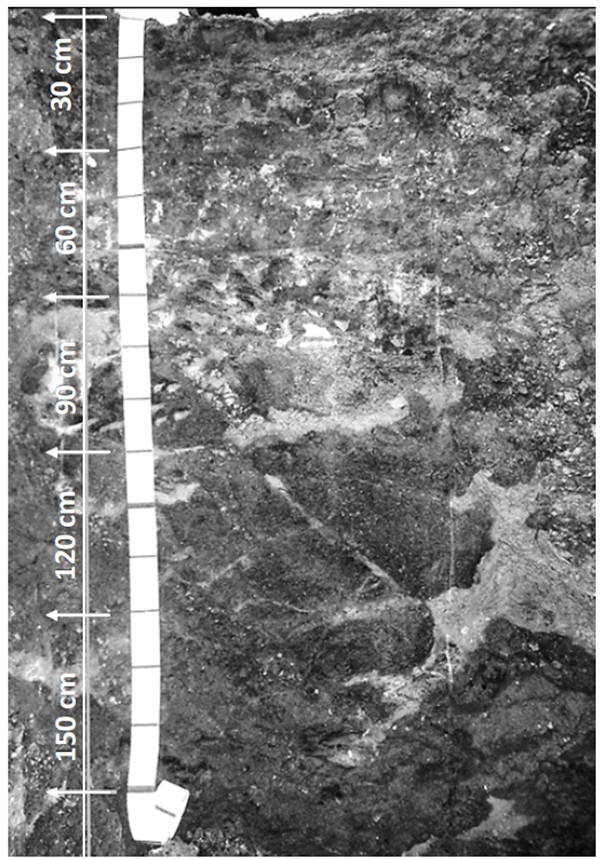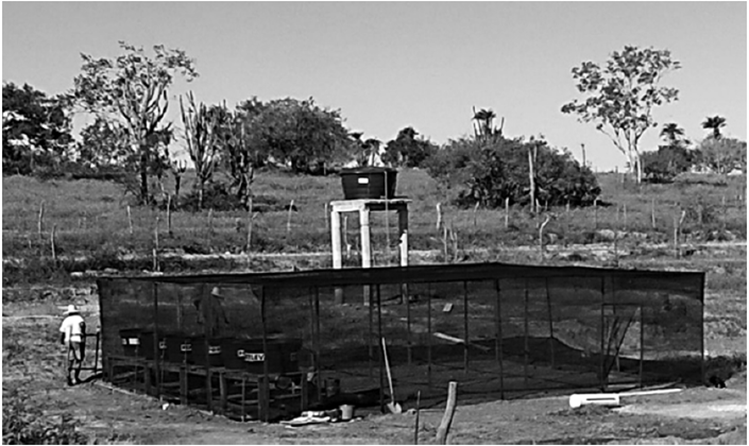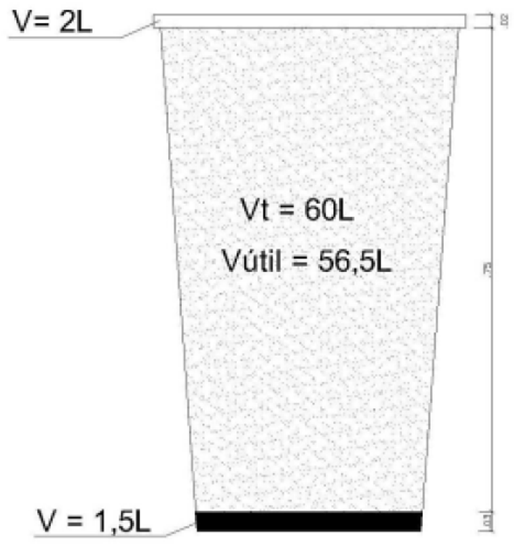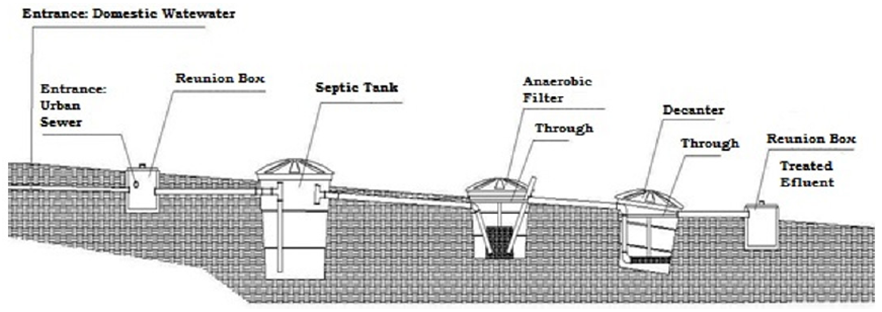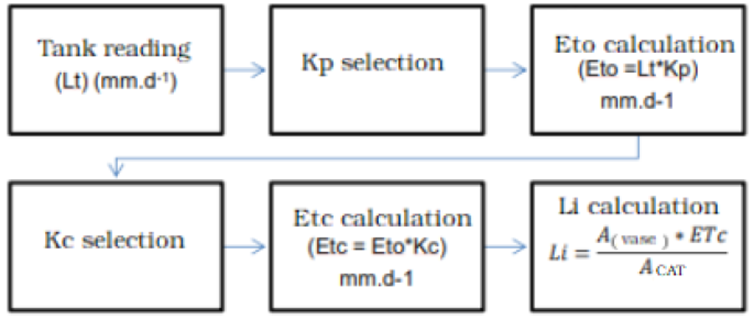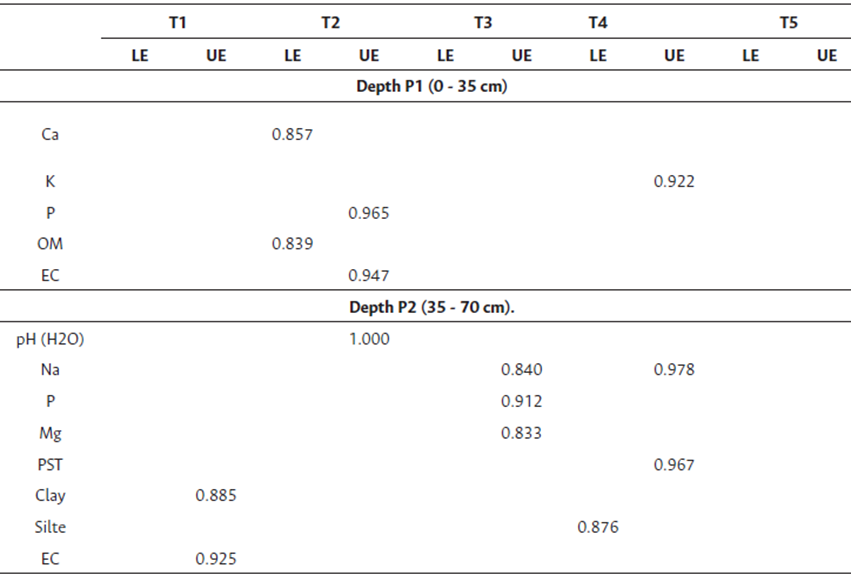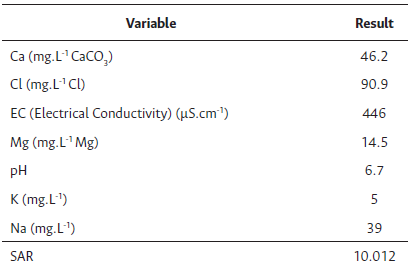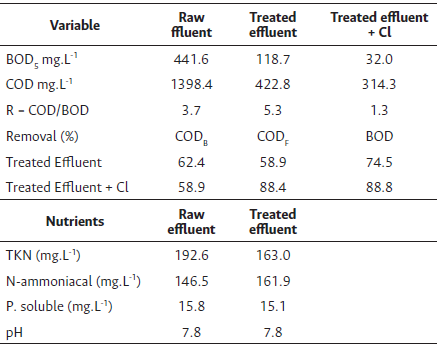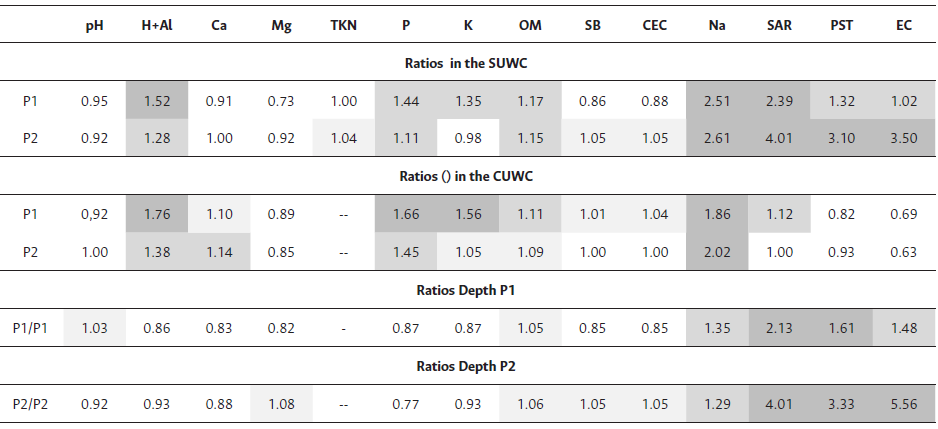Introduction
Domestic wastewater in rural areas is a mixture of black water from toilets (high organic load and suspended solids) and grey water from showers, kitchen use, and laundry (Calgaro and Barbudo Filho, 2020). In this sewage, heavy metals are not a concern for agricultural application, and micronutrients are frequently below toxic levels for crops (Shilpi et al., 2018).
Calgaro and Barbudo Filho (2020) addressed technologies for sanitation of rural areas. The biodigester septic tank is recommended, mainly due to its simple installation, operation, and design. This system alone has low biochemical oxygen demand (BOD) removal, which can be enhanced in combination with a septic tank with an anaerobic filter (Peters, 2018).
The reuse of treated wastewater (TWW) in agriculture is a common practice worldwide and can provide water and fertilizers for crops (Du et al., 2022).
The effects of TWW on the soil physicochemical attributes depend on the composition of the effluent, climate, soil type and crop features. Many deleterious physical effects are described, such as decrease in porosity and hydraulic conductivity, and increase in soil density, salinity, and sodicity (Souza et al., 2010). In addition, there can be negative effects for public health if pathogens are not removed during treatment (Al-Hamaiedeh, 2010).
Soil salinity and sodicity are the most deleterious effects for agricultural practices (Shrestha and Farshad, 2009). To remove salt crust from the root zone, Abrol et al. (1988) discussed three procedures, with leaching (pounding and infiltrating fresh water on the soil surface) being the most effective. However, in the semiarid soils of Brazil, this procedure is unfeasible due to freshwater scarcity.
A practical recommendation for semiarid regions is choosing salt-tolerant genotypes of different crops for food production (Pereira et al., 2017). Halophytic plants tolerate salinity from low (halotolerant) to extreme (halophytes) levels. Compounds produced by halophyte plants are important for animal feed and human food (Souza, 2018).
In Brazil, the salt plains of the northeast semiarid region have a wide biodiversity of halophytic plants (Souza, 2018). Among them, the saltbush (Atriplex nummularia) has the ability to extract salts and, hence, it has a high nutritional value as a supplement for ruminant feed (Attia- Ismail, 2018). Cultivation of halophyte species in the semiarid region of Brazil could be a good strategy for removing excessive salt from soil and serve as a food supplement.
Regarding the application time of TWW for soil salinization and sodification, the literature reports experiments developed for months (Du et al., 2022), few years (Rata et al., 2022), and many years, (Bekir et al., 2022). Gao et al. (2021) conducted a meta-analysis of 21 field studies without considering the cycle of annual or perennial crops. The studies received TWW applications from domestic sewage or food processing saline effluents. In comparison with conventional water irrigation, all studies concluded that TWW irrigation caused increase in soil salinity and electric conductivity (EC) while increasing cations for crop nutrition.
The present research is part of the governmental project of the state of Bahia named Social technologies for the efficient use of water for family agriculture in the semiarid region, aiming to help families overcome water limitation for irrigation, and produce their own food.
This study investigated changes in the physical and chemical characteristics of semiarid soil in the state of Bahia irrigated with domestic wastewater treated with an anaerobic sink-filter process. The effects of the wastewater on the soil with and without the corn cultivar (Zea mays L.) of the Poaceae family were examined.
Materials and methods
Study area: Location, climate, geology, and pedology
The experiment was set up in the rural area of Ouro Verde, municipality of São Domingos, state of Bahia, Brazil, adjacent to a local housing complex. São Domingos is located between the geographical coordinates 11°27’56” latitude south and 31°31’34”
longitude west (SEI-BA, 2009) (Figure 1).
According to the Thornthwaite climate classification, the soil is semi-arid, with an annual average temperature of 24.0 ºC. The annual rainfall distribution is irregular, from 400 to 600 mm, with undefined or absent rainy season, and significant water deficit (Figure 2).
The geology is dominated by crystalline rock complexes (CPRM, 2005). In Caraiba there are tectonic granitoids with orthogneisses; and in Santa Luz there are gneisses, quartzites, metamorphic and meta-ultramafic rocks. Two types of soils are predominant: Solosic Planosols, mineral soils poorly drained, B horizon dense with concentration of clay, and slow to very slow permeability; and Regolitic Neossols, mineral soils with thin organic material, and absent B horizon (EMBRAPA, 2006).
The soil of Ouro Verde was displayed in a trench in situ (1.0 x 1.5 x 1.5 m) (Figure 3). It is basically granulitic orthogneiss, Luvisol (TXo), mineral soil, not hydromorphic, B textural, and with high activity clay and base saturation (IBGE, 2007).
Setup of the experimental units
The experimental setup was protected by a wooden structure surrounded by a 50 % sombrite screen (Figure 4). A wooden bench (0.50 m high x 8 m long) supported the experiments, the treatment preparation, and the storage tanks (Figure 5).
The experiments involved twenty sampling units with cultivar (SUWC), in randomized blocks, using five treatments and four repetitions. The treatments used five levels of dilution of wastewater with water supply in the percentages 0 % (T1), 25 % (T2), 50 % (T3), 75 % (T4), and 100 % (T5). In addition, there were five control units without cultivar (CUWC), each one receiving a single treatment, and one white unit (WU), without treatment.
The experimental unit was installed in a 60 L plastic bucket (Figure 6), with a sealing rubber and a connector at the bottom for draining. At the bottom, 3 cm of gravel were accommodated, with a total volume of 1.5 L, covered by a geotextile blanket to separate the soil from the drainage layer. At the top, a layer of approximately 2 L was left without soil. The net soil volume in each bucket was 56.5 L.
Soil compaction protocol, sampling, and physicochemical analysis
The soil mass for the experiments was removed from the first 40 cm of the local land, with the horizons A (0 - 22 cm, loam texture) and B (22 - 40 cm, clay loam texture). The soil was sieved (sieve mesh No. 4 - 4.8 mm), homogenized, and quartered, and the boulders were removed. To reach the desired soil density, the methodology from Oliveira (1996) was used. For that, 2 kg of soil were distributed in layers, followed by a successive application of static pressure (60 times per layer) with a puncher (Figure 7), with 2.2 kg, a diameter of 25 cm and a stem of 98 cm. The average soil density in the 20 SUWC and 5 CUWC was 1.385 ± 0.005 g.cm-3, and the average porosity was 0.477 ± 0.002.
The buckets were saturated with 2 L of water using a fixed blade on top of the soil. The drainage occurred 3 days after the beginning of the saturation, which was the time to start sowing. The application of the treatments started at 10 days after planting (DAP), with daily periodicity. After 90 DAP, the experiment ended. One week after removing the plants, the soil samples were collected on 12/12/2014 and 12/19/2014.
For each bucket, two soil samples of 1 kg were collected after the soil was homogenized. The samples satisfied the combination of factors: depth for P1 (0 - 35 cm) and P2 (35 - 70 cm); treatment (T1 - T5); and unit type (CUWC and SUWC). Forty samples were collected from the twenty SUWC, due to the four repetitions, and ten samples were collected from the five CUWC. Besides, two soil samples were taken from the WU for the depths P1 and P2, totalling 52 soil samples.
The soil samples were analysed at the soil laboratory of the Instituto Tecnológico e de Pesquisas do Estado de Sergipe (Institute of Technology and Research of the State of Sergipe - ITPS) to determine the same fifteen physicochemical parameters described above. In addition, the parameter Total Kjeldahl Nitrogen was determined in the Soil Laboratory Luiz de Queiroz (ESALQ) of the School of Agriculture of the University of São Paulo.
Cultivar for the experiments
The cultivar was corn, variety Zea mays L., family Poaceae, commonly used in the semiarid region of Bahia due to its easy adaptation and relative short cycle (60 - 120 days). The seeds (BRS-Catingueiro variety), well adapted to the region, were distributed by the Secretary of Agriculture of São Domingos (2013 - 2014), and were used in this work.
In São Domingos, the farmers produce corn in rainfed agriculture (March to June) without land preparation and chemical fertilization (Carvalho et al., 2004). The crops are planted in small plots and the harvesting procedures involve the whole family. Once the corn matures (90 - 120 days), the ears are collected, and the chaff is removed from the field.
Cruz et al. (1990) describe a variety of pests that feed on corn. Among them are crickets and grasshoppers, very common in the region. During the experiments, from 08/20/2014 to 12/03/2014, the workmen made daily visual observations and no pest attacks were registered with no need of chemical control.
To reproduce the same soil conditions used by the farmers, the soil for the experiments did not receive any especial preparation or chemical fertilization. As the focus of this work (Silva, 2015b) were the soil physicochemical changes, no control of the corn growth was performed. However, some results for corn crop development in buckets from Silva (2015a) will be presented here. The work of Silva (2015a) was developed in parallel with Silva (2015b), using the same soil, the same treatments, and the same experimental setup in Ouro Verde.
Sewage treatment system
Figure 8 shows, from left to right, the entrance of the domestic wastewater in the septic tank/filter system, which comprises two fiberglass tanks interconnected, the first with 10 000 L (septic tank), and the second with 5000 L (upstream anaerobic biological flow filter). This is a closed reactor where the organic matter is consumed by the anaerobic microorganisms while the sewage flows. Next comes a secondary decanter (PVC tank) and a concrete reunion box. The treated wastewater was elevated to a PVC tank, seen in Figure 4. For disinfection, chlorine tablets applied with a chlorine feeder inside the reservoir (PVC tank) were used in this work.
This system was designed to serve 30 families, 8 from the Condominium Ouro Verde and 22 from the neighbourhood, which launches its sewage into the condominium area. The project’s estimated flow was of 12 000 L.d-1.
Irrigation management
he five treatments were prepared in 250 L tanks. The irrigation blade was calculated based on the evaporation class A (ECA) from a class A tank (CAT), a recommendation from FAO Bulletin 56 (Allen et al., 1998). The CAT was placed 3 m away from the experimental structure, on a wooden pallet platform. Knowing the evaporation blade (in daily basis), the flowchart (Figure 9) presents the procedure to calculate the irrigation blade. This calculation depends on the parameters Kp (CAT-coefficient), ETo (evapotranspiration, in mm.d-1), Kc (Crop-coefficient), and ETc (crop evapotranspiration, in mm.d-1).
The methods to calculate Kp require the values of relative humidity (H), wind speed (U), and the characteristics of the surrounding area of the CAT. The authors Sousa et al. (2016) and Braga et al. (2008) evaluated the adequacy of several methods (Pereira et al., 1995; Snyder, 1992; Cuenca, 1989) compared to the standard Penman-Monteith from FAO Bulletin 56 (Allen et al., 1998). They found that i) the methods are comparable, but present low correlations with the standard model; ii) the methods of Pereira et al. (1995) and Cuenca (1989) presented the best results; iii) a simple method to estimate ETo using a fixed value (Kp = 0.71) produced similar results in comparison with the two best methods; iv) for the semiarid region of Bahia, a fixed value (Kp = 0.75) is widely used by irrigation managers, though the overestimated ETo is 37 %. Nonetheless, for simplicity reasons, the present work used this fixed value Kp = 0.75 to calculate ETo.
To define the crop coefficient (Kc), Doorenbos and Pruitt (1977) developed comprehensive studies for a variety of cultivars and climatic conditions. They considered four stages for crop development (initial, crop development, mid-season, and late season at maturity). For corn cultivars, an average between 0.6 and 1.15 or between the stages (mid-season and maturity) was recommended by the authors, thus, a Kc value of 0.85 was adopted for the present work. This number attends the characteristics corn cultivar grain, 90 DAP (stage of corn maturity), semiarid, humidity < 20 %, wind 0 - 5 m.s-1, planting (3 days after soil saturation), and irrigation in daily base starting at 10 DAP.
Results and discussion
Ouro Verde soil characterization
The in situ soil samples were chemically and physically analysed in the Soil Laboratory ITPS, Aracajú-SE, with procedures from EMBRAPA (2006).
Fifteen parameters were determined: pH, Ca, Mg, K, Na, P, Al3, Al+H, CEC, SB, V%, M%, EC, PST, and SAR, in addition to the fractions of clay, silt, and sand.
Table 1 presents the chemical characterization of soil profile for horizons: A (loam, with abundant small pores), B (clay loam, with frequent small pores), BC (clay loam), and C (sandy loam, with few small pores). Horizons A, B and C (EC < 4 dS/m) have normal salinity with favourability for agricultural practices. Horizon BC (PST > 15 %) has sodic character. The percentage of soil boulder in mass is 1 - 3 %. The abundant or frequent small pores in A and B are unfavourable for irrigation with treated wastewater, due to long-time water residence and risk of soil salinization.
Soil from SUWC: physical and chemical parameters and statistical analysis
The descriptive statistics, with emphasis in the coefficient of variation, served to evaluate the degree of variability of the chemical and physical parameters. The variability scale from Gomes (1984) is: low (CV < 10 %), medium (10 % = CV < 20 %), high (20 % = CV < 30 %), and very high (CV > 30 %).
In the analysis, Dixon’s Q Test (Barbetta, 2005) was used for data consistency to detect outliers. The number of observations (4 repetitions) in the interval 3 ≤ n ≤7, with NC = 95 %, has a critical value of D = 0.829, above which the discrepancy occurs. The experimental D is calculated by
The Tukey’s test (Walpole, 2009) served to evaluate the difference between the averages from the two treatments. The minimum significant difference was < 0.05. It is calculated by
, where q = total amplitude; QMRes = mean square of the residue; and r = 4 repetitions. All statistical tests were performed using an Excel spreadsheet.
Based on Table 2, for CV values in SUWC, at depth P1, 44 % of the parameters presented high to very high variability, and 50 % at depth P2. At the two depths, the parameters Na, K, Mg, SB, CEC, and silt presented high variability, while for P, H+ Al, PST, CE, and SAR it was very high. According to Gomes (1984), high and very high variability are common for very poor soils or for a small number of repetitions (n = 4).
Table 2 High and very high coefficient of variation of chemical and physical properties of soil samples at P1 and P2
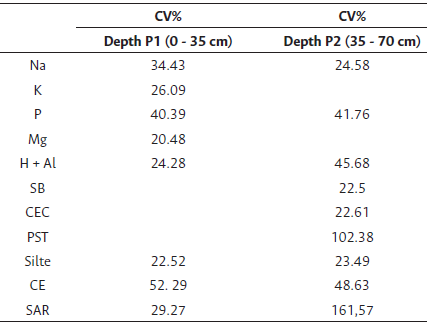
Table 3 presents the results of Dixon’s Q Test. From 360 soil physicochemical analyses at P1 and P2, 14 presented results above the critical value (D > 0.829). The small number of repetitions (n = 4) allowed such variability, but these values were considered in the sample.
Ouro Verde water supply, raw and treated sewage
The supply water was analysed in the physicochemical laboratory of the Universidade Federal da Bahia (LABDEA/UFBA), with procedures of the standard methods (Rice et al., 2017) for pH, EC, Ca, Mg, Na, K, and SAR. The classification for irrigation purposes proposed by the U.S. Salinity Laboratory was used as a reference (Richards, 1954).
The sewage samples were collected weekly, from 08/20/2014 to 12/03/2014, and analysed in the Laboratory LABRE/UFBA for BOD5, COD, and COD/BOD ratio. The removal percentage in treated and treated + chlorination sewage, as well as the percentage for TNK, P-total, and pH were determined. The sewage classification followed Metcalf & Eddy (2003).
No investigation was performed for microbial population in the treated sewage, as the anaerobic process is efficient for microbial removal (Peters, 2018). Heavy metals were neither analysed, as they are from industrial source (Shilpi et al., 2018), as well as household chemicals due to the low use of these products in rural areas with low-income population.
Based on Table 4, the Ouro Verde supply water has the following characteristic for irrigation: the average value for EC (446 µS.cm-1) indicates classification C2, or medium grade salinity. The value SAR (10.0), with classification S2, indicates a sodification process. The class C2S2 is not recommended for clayey texture, due to larger water retention (Ribeiro et al., 2016). In the mixture of horizons A and B (loam and clay loam) from Ouro Verde, sodium can negatively change the soil characteristics and affect the cultivar.
Based on Table 5 and the classification by Von Sperling (2005) for Brazilian sewage average range, the treated sewage presented the following characteristics: the average BOD and COD are below the ranges (BOD: 250 - 400; COD: 450 - 800 mg.L-1).
However, COD/BOD ratios (5.3) are above the easily biodegradable range (1.7 - 2.4). The average TNK and N-ammoniacal are above the range (35 - 60 mg.L-1); also for P values, which were above (4 - 13 mg.L-1). Probably, these findings are due to the limited use of water for sanitary purposes in the semiarid region. The pH value (7.8) is adequate for irrigation. Thus, the Ouro Verde treated domestic sewage is not easily biodegradable, but has a large contribution of elements for soil nutrition.
Results for plant development
The experiments from Silva (2015a), similarly as Silva (2015b), the same cultivar and the same five treatments with irrigation blades of 60 %, 90 %, 120 %, and 150 % of ECA. A factorial scheme (5 x 4), with four repetitions, evaluated twenty treatments on corn productivity. Sowing occurred on 08/21/2014, after three days of soil saturation and drainage. The treatments started at 10 DAP, with analysis for corn development every 15 days.
In the corn productive phase, at 90 DAP, Silva (2015b) measured eight parameters, however, only the plant height is presented here. The height 171.62 cm was obtained for 100 % of the treated wastewater (blade = 150 % x ECA); and 118.12 cm for 0 % of the treated wastewater (blade = 150 % x ECA). The difference of 53.50 cm on the plant height indicates the importance of treated wastewater for plant nutrition. The height 171.62 cm is comparable with the interval 170 - 190 cm from EMBRAPA (2010) for the corn variety Catingueiro.
By inference, this may have also happened in the experiments of Silva (2015b). If so, regardless the changes in the soil physicochemical properties, the contribution of treated wastewater for corn growth is significant.
Experimental data and changes in the soil chemical attributes
Table 6 presents the results for seventeen physicochemical parameters at the two depths (P1 and P2) for CUWC, and Table 7 for SUWC. Both tables show the results for WU. Table 7 shows which result attended the Tukey’s test at the probability level of 5 %.
Table 6 Soil chemical and physical results in the CUWC, at depths P1 and P2, with five treatments, and in WU
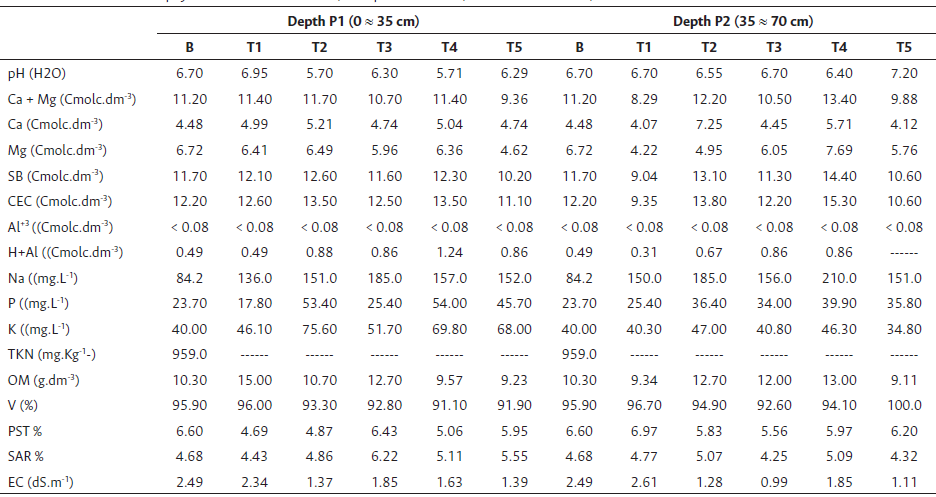
Table 7 Soil chemical and physical results in the SUWC, at depths P1 and P2, with five treatments, and in WU
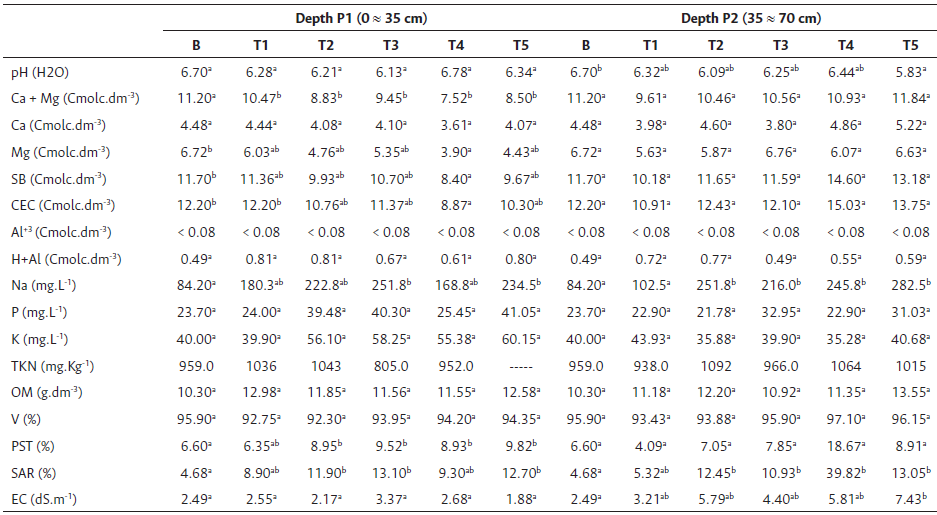
Note: Averages followed horizontally by the same letter (superscript) do not differ at the 5 % probability level by the Tukey’s test.
Table 8 presents the calculations of the ratios , between , which is the average value of the chemical and physical attributes for CUWC and SUWC, and the respective value in WU, as well as the ratios , calculated to understand how the cultivar affected the chemical characteristics of the soil. These ratios were selected by numerical intervals and shaded accordingly. In comparison to WU, the cases are Case 1 (no shading, 0.63 - 1.00), meaning reduction or no- change; Case 2 (lighter gray, 1.01 - 1.10), increase; Case 3 (medium gray, 1.11 - 1.48), significant increase; and Case 4 (dark gray, > 1.50), increase above 50 %.
Based on Table 8, for SUWC at P1, Case 1 occurred for pH, Ca, Mg, TNK, SB, and CEC, most probably due to cation consumption by cultivars. Cases 2 and 3 occurred for P, K, OM, PST, and EC due to addition of nutrients and OM by the sewage. Case 4 presented for H+Al, Na, and SAR with a potential acidity increase. The increase of Na in the exchange complex by 151 % elevated the risk of sodification (SAR, PST), and the increase of soluble salts elevated the risk of salinization (EC). For SUWC at P2, the ratios for Na, SAR, PST, and EC were even higher (Case 4), with even larger risk of sodification and salinization.
Based on Table 8, for CUWC at P1 and P2, eleven ratios out of 26 in Case 1 show the impact of the absence of cultivar and no consumption of cations. Regardless the significant contribution of Na by the treated sewage, the risks of sodification and salinization were reduced, indicating that the cation exchange complex was not affected significantly.
To clearly identify the changes in soil characteristics related to the presence or absence of cultivars, the ratios are helpful. For both depths, 12 out of 26 ratios in Case 1 (0.77 - 0.93) for Ca, Mg, P, K, SB, and CEC indicate larger consumption of cations by the cultivars in SUWC. On the other hand, eight ratios in Cases 3 and 4 (1.24 - 4.01) for Na, SAR, PST, and EC indicate the elevation of Na in the soil cation exchange site, also as a result of the cation consumption by the cultivars in SUWC.
Conclusions
This work reports experiments done on soil from the semiarid region of the state of Bahia, Brazil. The 3-month (90 DAP) application of TDW by anaerobic process in the sampling unit (SUWC) with corn, and the control unit (CUWC), allowed the following main conclusions:
The CUWC presented average percentages of Ca, P, K, and OM 5 - 66 % higher than the white unit (WU); while for SUWC, the percentages were 0.0 - 44 %, due to the consumption of cations by the cultivar. The SUWC presented percentages of Na, SAR, PST, and EC from 35 - 113 % higher at P1, and 29 - 456 % higher at P2, due to cation consumption by the cultivars with elevation of the Na contribution to the soil cation exchange site. A quite similar result to others reported in the literature. Despite the short cycle of the cultivar, the SUWC indicated predisposition for soil sodification (elevation of PST) and salinization (elevation of EC). Increase in salinization has negative effects on soil and cultivar. Despite the predisposition for sodification and salinization, the work of Silva (2015b), developed under similar conditions, identified a favourable treatment to corn development, being the plant height in the expected range. For future studies, the research group pretends to work with a consortium of two cultivars: a short- cycle cultivar and a shrub halophyte species, due to its ability to extract salts from the soil. The expected result is the reduction in soil salinity while growing crops for human feeding and helping to produce food for local livestock.













